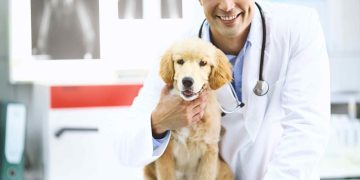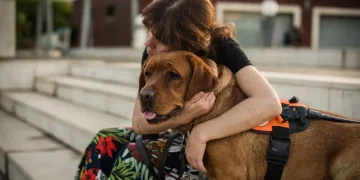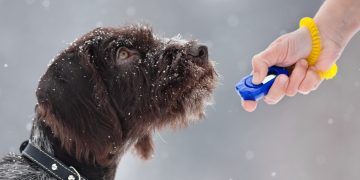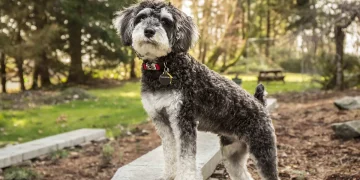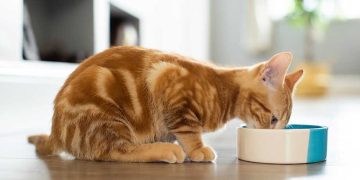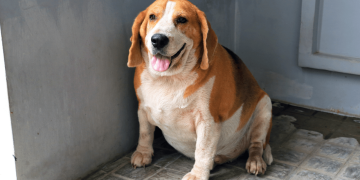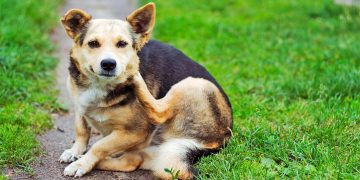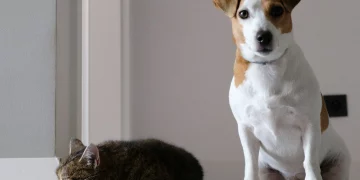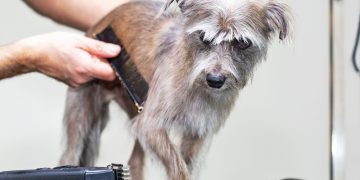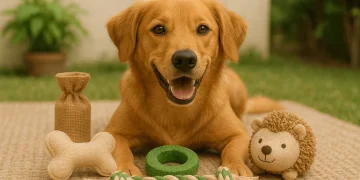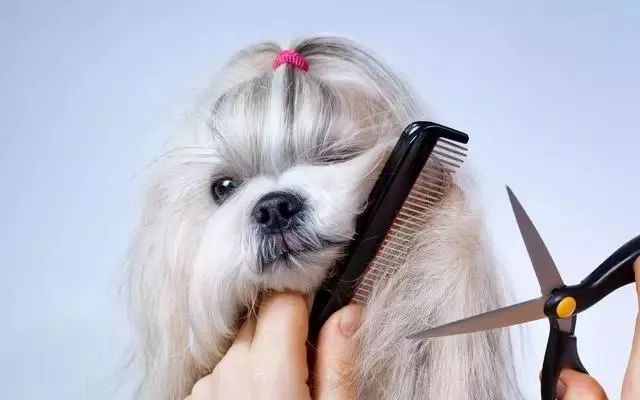Regular grooming is essential for maintaining your dog’s health and comfort. While some dogs need frequent haircuts, others may not require trimming at all. Understanding when and why your dog needs a haircut depends on several factors, such as their breed, coat type, and lifestyle. In this article, we will explore how to determine if your dog needs regular haircuts, the benefits of grooming, and tips for keeping your dog’s coat healthy.
Why Is Grooming Important for Dogs?
Grooming goes beyond just aesthetics. It’s an essential aspect of maintaining your dog’s overall health. Proper grooming helps:
- Prevent Matting and Tangling: Regular haircuts and brushing prevent the fur from becoming tangled and matted. Mats can cause discomfort, and if left untreated, they can lead to skin infections or irritations.
- Promote Healthy Skin: Grooming helps remove dirt, debris, and dead hair that can build up in your dog’s coat. This allows the skin to breathe and reduces the risk of infections.
- Reduce Shedding: Frequent trimming or brushing helps manage shedding, making it easier to maintain a clean home.
- Prevent Overheating: Long or dense fur can trap heat, leading to overheating, especially during hot weather. Regular haircuts help your dog stay cool.
- Identify Health Issues Early: Grooming sessions give you a chance to check your dog’s skin for any abnormalities, such as bumps, cuts, or parasites like fleas and ticks.
Factors to Consider When Deciding If Your Dog Needs a Haircut
1. Breed and Coat Type
One of the main factors that determine if your dog needs regular haircuts is their breed and coat type. Dogs with certain types of coats require more frequent grooming than others.
- Long-Haired Breeds: Dogs with long or continuously growing hair, like Poodles, Shih Tzus, Maltese, and Yorkshire Terriers, typically need regular haircuts to prevent their hair from becoming tangled and matted. These dogs benefit from professional grooming every 4-6 weeks.
- Curly-Coated Breeds: Breeds like Poodles, Bichon Frises, and Portuguese Water Dogs have curly hair that grows constantly. They require frequent trimming and regular grooming to avoid tangles and matting.
- Double-Coated Breeds: Double-coated breeds, such as Golden Retrievers, Labrador Retrievers, German Shepherds, and Siberian Huskies, do not need frequent haircuts, but they benefit from regular brushing to remove loose undercoat hair. While their coats should not be shaved, trimming the hair around the paws or tail may be necessary for cleanliness.
- Short-Haired Breeds: Breeds with short coats, like Beagles, Chihuahuas, and Boxers, generally don’t need regular haircuts. However, they still benefit from occasional brushing to remove loose fur and keep their coat shiny.
2. Grooming Preferences and Health Considerations
Aside from the breed, grooming needs can vary depending on your dog’s health and lifestyle.
- Dogs with Skin Sensitivities or Allergies: If your dog has skin issues such as allergies, rashes, or sensitivities, regular haircuts may help improve air circulation to the skin and reduce irritation. Shorter hair can also make it easier to treat skin conditions.
- Health Conditions: Older dogs or those with certain medical conditions, like arthritis, may not groom themselves properly, leading to matting. A regular haircut can help alleviate any discomfort and make grooming easier for both you and your dog.
- Active Dogs or Working Dogs: If your dog is highly active or works outdoors, regular haircuts can help them stay cool and clean, preventing mats and tangles that might occur from outdoor activities.
3. Seasonal Changes and Temperature Control
Your dog’s grooming needs may also change with the seasons. During summer, dogs with thick, long coats may need more frequent haircuts to stay cool. Conversely, during winter, you may want to leave your dog’s coat longer to help protect them from the cold, especially if they spend time outdoors.
- Summer Grooming: For dogs with long or thick coats, trimming hair in warmer months can help keep them cool and comfortable. Shorter coats allow better air circulation and prevent your dog from overheating. However, be careful not to trim the hair too short, as the coat helps protect your dog from sunburn.
- Winter Grooming: In colder months, it’s best to keep your dog’s coat at a length that helps insulate their body and keep them warm. Shaving a double-coated breed during winter is not recommended, as they need their full coat for temperature regulation.
4. Matting and Tangles
Matting is a common problem, especially for dogs with long or curly coats. If you notice that your dog’s fur is getting tangled or matted, it’s a sign that they may need a haircut. Matting can cause discomfort and even pain for your dog, as it pulls on their skin. It can also lead to skin infections if left untreated.
- Signs of Matting: If your dog’s fur is becoming stiff, clumpy, or difficult to brush through, it’s likely matted. Matting can be particularly noticeable around the armpits, ears, and the underside of the body, as these areas tend to collect tangles.
- Dealing with Mats: While some mats can be brushed out, others may require trimming to remove them safely. If the mats are severe, you might need to take your dog to a professional groomer to prevent injury.
5. Grooming Maintenance Between Haircuts
Even if your dog doesn’t require frequent haircuts, regular grooming between trims is still important. Regular brushing helps maintain the health of their coat and keeps their fur from becoming matted. Here’s what to do between haircuts:
- Brushing: Brush your dog’s coat regularly to remove loose fur, prevent tangles, and reduce shedding. Long-haired breeds require more frequent brushing, sometimes daily, while short-haired dogs only need to be brushed a few times a week.
- Nail Trimming: Regular nail trimming is essential for your dog’s health. Long nails can cause discomfort and even lead to injury.
- Ear Cleaning: Keep your dog’s ears clean, as dirt and moisture can lead to infections, particularly in breeds with floppy ears.
- Bathing: Regular baths, depending on your dog’s breed and activity level, help maintain their hygiene and coat health.
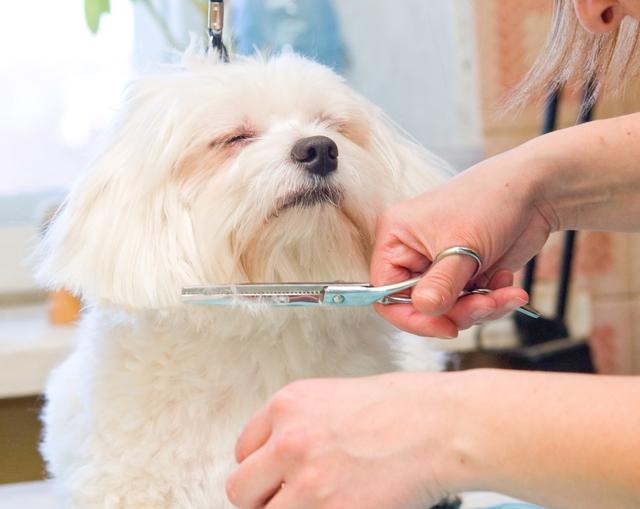
How to Determine if Your Dog Needs a Haircut
Here are some specific signs that indicate it’s time for a haircut:
- Matted Fur: If your dog’s fur is too matted to brush out easily, it’s time for a trim.
- Excessive Shedding: If your dog sheds excessively and you’re struggling to manage the hair around the house, regular haircuts can help control the shedding.
- Discomfort or Irritation: If your dog seems uncomfortable, scratches excessively, or licks certain areas of their body, it could be due to matting or tangling in the fur.
- Change in Behavior: If your dog becomes restless or agitated due to their fur becoming tangled or heavy, they may need a trim to feel more comfortable.
- Overheating: If you notice that your dog is panting excessively, especially in warm weather, it could be a sign that their fur is too thick, and a trim might help them stay cool.
Tips for Grooming Your Dog at Home
While professional grooming services are available, you can also learn how to groom your dog at home. Here are some tips:
- Invest in Proper Tools: Make sure you have the right tools for the job, such as grooming scissors, clippers, brushes, and combs that suit your dog’s coat type.
- Start Slowly: If your dog is not used to haircuts, start with short grooming sessions to help them get used to the process.
- Stay Calm: Be calm and gentle during grooming. Dogs can pick up on your energy, so staying relaxed will help them feel more comfortable.
- Know When to Seek Professional Help: If you’re unsure how to trim your dog’s coat or if your dog is nervous about grooming, it’s best to seek help from a professional groomer to avoid causing stress or injury.
Conclusion
Whether your dog needs regular haircuts depends on their breed, coat type, health, and lifestyle. Long-haired or curly-coated breeds generally require more frequent grooming to prevent matting and tangling, while short-haired breeds may only need occasional attention. Additionally, grooming should be part of your dog’s overall health routine to ensure they stay comfortable and free from skin or coat issues.
By paying attention to your dog’s grooming needs and maintaining regular haircuts, you help ensure they remain happy, healthy, and comfortable. If you’re ever unsure about whether your dog needs a haircut or how to go about it, consult your veterinarian or a professional groomer for advice tailored to your dog’s specific needs.

